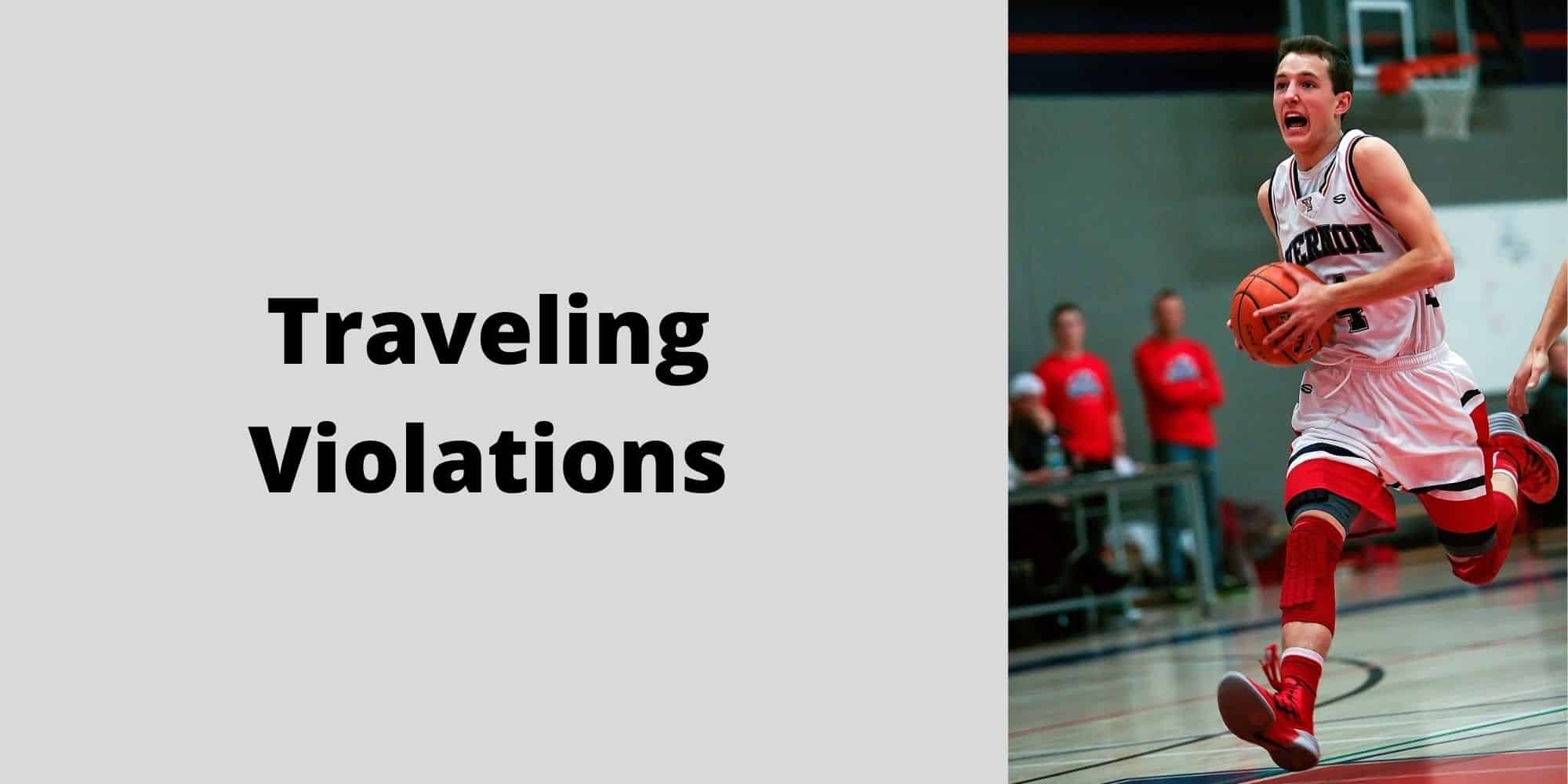Yes, basketball can take you around the world, but when we speak of traveling in basketball we are usually talking about the rule that many seem to have forgotten.
It’s one of the most basic rules of the game. Players learn it from the very beginning along with the game’s fundamentals. So, what is traveling in basketball?
Traveling Defined
Beginners sometimes simplify traveling to running with the ball without dribbling it. While that certainly is a form of traveling, it’s just one of many.
Meanwhile, the NBA definition in Section 13 of the league’s rulebook takes a simple concept and makes it difficult to understand. Eight different points, including a few sub-points, are made to explain a rule that can be greatly simplified. Here is a simple definition of traveling:
Traveling in basketball occurs when a player in control of the basketball makes an illegal move with their feet.
But what constitutes an ‘illegal move’? To understand any type of illegal move with the basketball, we first must understand the pivot foot. It’s essential you understand this part to understand traveling.
The Pivot Foot
As young players learn the game and its basic fundamentals, they learn about the pivot foot.
The pivot foot is one that must remain in contact with the floor. It can be either the right or left foot, but a player with the basketball that is not dribbling and is stationary must have one foot in contact with the floor at all times. The player can move but only with the pivot foot anchored to the floor.
The establishment of the pivot foot is what helps to determine a traveling call. Understanding the pivot foot and how it works allows us to understand what makes up an illegal movement with the ball.
Common Illegal Moves
There are a number of movements with the basketball that will cause a referee to call traveling.
1. Lifting the pivot foot before ball passing or shooting
The most common is simply lifting the pivot foot once it has been established. A player moves the non-pivot foot and then moves the pivot foot before passing or shooting the basketball. This is traveling.
2. Lifting the pivot foot before releasing the ball to dribble
Sometimes, players will lift the pivot foot before they release the ball to begin dribbling. This is another illegal movement.
This is a fairly common form of traveling and it can be a difficult call for officials to make, as the move happens very quickly.
3. Jumping and coming back down before release
If a player controls the basketball and jumps – leaving the floor with both feet – and comes back down with the ball before shooting or passing, a traveling violation has occurred.
4. Taking more than two steps while moving
Traveling can also occur when a player receives the ball while moving. A player can catch the basketball on the run and take two steps before stopping, passing, or shooting. There are times when a player takes a third step. That is a traveling violation.
Other Illegal Movements and Traveling Situations
Other illegal movements include:
- The Pivot Slide: Dragging or sliding the pivot foot while pivoting
- Falling to the floor without maintaining a pivot foot
- Rolling off the floor with the basketball in hand
Each of these movements results in a called traveling violation.
In addition to these more common traveling situations we’ve just discussed, there are others that occur less often.
One already mentioned is a player that falls to the floor without maintaining a pivot foot or without dribbling. The same traveling call is made if a player on the floor stands up with possession of the ball without dribbling.
Other situations include the illegal step-back for a three-point shot and the rebound shuffle. A player receives a pass just in front of the three-point arc. The player lifts the non-pivot foot and then also moves the pivot foot to relocate behind the line. That is considered traveling. The same is true when a player grabs a rebound and then shuffles their feet or even falls down. If the player is not dribbling, a traveling violation has occurred.
Traveling and the NBA
As the game’s premier basketball league, the NBA is about one thing – making money. Games that are frequently interrupted by referees’ whistles for traveling violations are not what drive fans to buy tickets and watch games on television.
Watching an NBA game, fans will see multiple occurrences of what appear to be traveling violations. Most, if not all, will go by without a whistle. The league attempts to explain away these obvious violations of the rule with something called the “gather step.”
For those that watch NBA games, there are a number of shooters that utilize a step-back move to ensure they are shooting from behind the three-point line. If watching carefully, fans can see that indeed these shooters pick up their dribble and then move their non-pivot foot followed by their pivot foot. At all levels of the game, this is a traveling violation.
The NBA does not call it a travel. Instead, referees are to interpret that move as a “gather step” or the time between when a player ends his dribble and either drives to the basket or takes his shot.
Oftentimes, it happens so quickly that it’s hard to determine whether or not a player did travel. Whether they did or not, the NBA’s desire to keep the game moving – to keep its fans coming back for more – supersedes a traveling violation. Therefore, referees just don’t call it.
The Deceiving Euro Step
An extremely popular and elegant basketball maneuver is the euro step. This happens when an offensive player picks up their dribble, takes a step in one direction before quickly taking a second step in the other. It is an evasive tactic that intends to trick the defender into going the wrong way.
This is definitely a move that can look like an instance of traveling, but it is not. However, it does rely on performing a well-executed “gather step” beforehand, which is difficult to time and will easily have the referee calling a travel violation if not done perfectly. Because of how difficult it is for referees to read the whole move, in high-school basketball, a perfectly executed euro step might be wrongly penalized!
The Official Rule As Defined By The NBA
Now that we have a general understanding of what traveling constitutes, it’s a good time to revisit the NBA’s own definition of traveling. Though complex, thorough, and open to some degree of interpretation, this is the most complete definition.
- A player who receives the ball while standing still may pivot, using either foot as the pivot foot.
- A player who gathers the ball while progressing may take (1) two steps in coming to a stop, passing or shooting the ball, or (2) if he has not yet dribbled, one step prior to releasing the ball. A player who gathers the ball while dribbling may take two steps in coming to a stop, passing, or shooting the ball.
- The first step occurs when a foot, or both feet, touch the floor after gaining control of the ball.
- The second step occurs after the first step when the other foot touches the floor, or both feet touch the floor simultaneously.
- A player who comes to a stop on step one when both feet are on the floor or touch the floor simultaneously may pivot using either foot as his pivot. If he jumps with both feet he must release the ball before either foot touches the floor.
- A player who lands with one foot first may only pivot using that foot.
- A progressing player who jumps off one foot on the first step may land with both feet simultaneously for the second step. In this situation, the player may not pivot with either foot and if one or both feet leave the floor the ball must be released before either returns to the floor.
- In starting a dribble after (1) receiving the ball while standing still, or (2) coming to a legal stop, the ball must be out of the player’s hand before the pivot foot is raised off the floor.
- If a player, with the ball in his possession, raises his pivot foot off the floor, he must pass or shoot before his pivot foot returns to the floor. If he drops the ball while in the air, he may not be the first to touch the ball.
- A player who falls to the floor while holding the ball, or while coming to a stop, may not gain an advantage by sliding.
- A player who attempts a field goal may not be the first to touch the ball if it fails to touch the backboard, basket ring or another player.
- A player may not be the first to touch his own pass unless the ball touches his back- board, basket ring or another player.
- Upon ending his dribble or gaining control of the ball, a player may not touch the floor consecutively with the same foot (hop).
- PENALTY: Loss of ball. The ball is awarded to the opposing team on the sideline, nearest spot of the violation but no nearer the baseline than the foul line extended.
Source: The Official NBA Rulebook – Violations and Penalties, Rule 10 Section XIII
Summary
Traveling in basketball can be as simple as running with the ball in your hands, but at high-level play, it is almost always much, much more subtle.
Don’t worry too much if the rules surrounding traveling are overwhelming. Even seasoned basketball players will struggle to provide a thorough definition of traveling in words. It’s something you will ‘feel’ as a player and ‘see’ as a spectator. As a result, you should play basketball and watch basketball to get more familiar with the rule.
Finally, remember that while the concept of traveling exists across all leagues, the definitions do vary slightly. Wikipedia provides a comprehensive overview of traveling definitions according to the NBA, NCAA, NFHS and FIBA.

